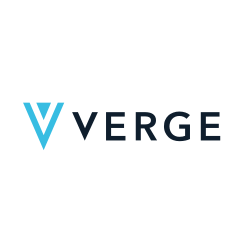Verge (cryptocurrency)
 | |
| Denominations | |
|---|---|
| Symbol | XVG |
| Development | |
| White paper | Blackpaper Verge Currency 5th edition |
| Initial release | 2014 |
| Code repository | github.com/vergecurrency |
| Developer(s) | Justin Sunerok |
| Ledger | |
| Block time | 30s |
| Block explorer | verge-blockchain.info |
| Website | |
| Website | vergecurrency.com |
Verge Currency is a decentralized open-source cryptocurrency which offers various levels of private transactions. It does this by obfuscating the IP addresses of users with Tor and by leveraging stealth transactions making it difficult to determine the geolocation of its users.[1]
Verge Currency has a maximum supply capped at 16.5 billion XVG. It uses the Proof of Work (POW) mining principle with multi-algorithm support and 5 different hash functions: Scrypt, X17, Lyra2rev2, myr-groestl and blake2s.[2][3]
History
[edit]Verge Currency was created in 2014 and originally named DogeCoinDark. It was rebranded to Verge Currency in 2016.[1]
Following the bitcoin principle, Verge Currency has a transparent ledger that allows anyone to view all of its transactions, but protects user identities and locations. This was achieved by integrating both Tor to not expose IP addresses[1] and using stealth transactions, formerly known as Wraith Protocol, to hide the value of transactions.
In April 2018, it was announced that the adult entertainment provider MindGeek would begin accepting Verge Currency as a payment option on its website network.[4]
Also during April and May 2018, Verge Currency suffered from timestamp exploit on one of its 5 mining algorithms. This could have resulted in a 51% attack if it had only one algorithm.[5][6]
References
[edit]- ^ a b c Koerhuis, Wiebe; Kechadi, Tahar; Le-Khac, Nhien-An (October 31, 2019). "Forensic analysis of privacy-oriented cryptocurrencies". Forensic Science International: Digital Investigation. 33: 200891. doi:10.1016/j.fsidi.2019.200891. S2CID 213272949.
- ^ Li, Jingming; Li, Nianping; Peng, Jinqing; Cui, Haijiao; Wu, Zhibin (November 14, 2018). "Energy consumption of cryptocurrency mining: A study of electricity consumption in mining cryptocurrencies". Energy. 168: 160–168. doi:10.1016/j.energy.2018.11.046. S2CID 117167104.
- ^ Li, Yannan; Susilo, Willy; Yang, Guomin; Yu, Yong; Du, Xiaojiang; Liu, Dongxi; Guizani, Nadra (September 2019). "Toward Privacy and Regulation in Blockchain-Based Cryptocurrencies". IEEE Network. 33 (5): 111–117. doi:10.1109/MNET.2019.1800271. ISSN 0890-8044. S2CID 86487140.
- ^ Morris, Chris (April 17, 2018). "Porn Partnership Pumps This Cryptocurrency Up 22%". Fortune. Archived from the original on 2018-07-12. Retrieved 2018-10-08.
- ^ Schroeder, Stan (April 5, 2018). "Verge cryptocurrency hack shows, no, blockchain isn't invincible". Mashable. Archived from the original on January 9, 2019. Retrieved January 21, 2019.
- ^ Haan, Cali (May 25, 2018). "Verge, Bitcoin Gold and MonaCoin Hacked". Crowdfund Insider. Archived from the original on January 8, 2019. Retrieved January 21, 2019.
